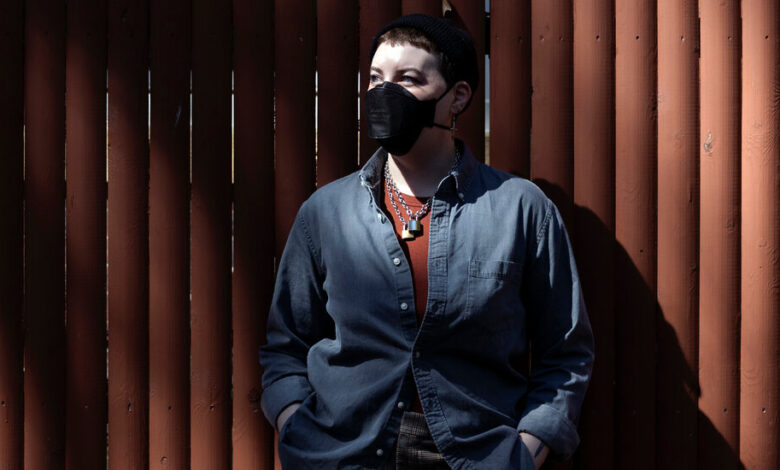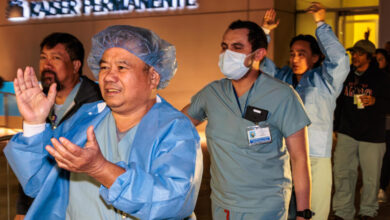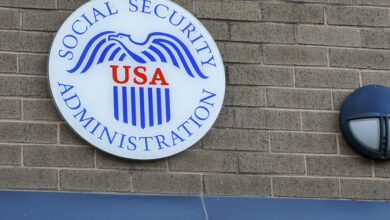
In Hospitals, Viruses Are Everywhere. Masks Are Not.
[ad_1]
Liv Grace came down with respiratory infections three times over the course of four months. Each occurred after a visit to a medical provider in the Bay Area.
Mx. Grace, 36, a writer who uses they/them pronouns, was infected with respiratory syncytial virus, which led to pneumonia, in December, after they were treated by a nurse wearing a surgical mask who complained about her children being ill with the virus.
Mx. Grace got Covid after a visit to a cancer center for an infusion in February. And there was the pale, coughing phlebotomist who drew blood in April, just before they came down with Covid again.
Mx. Grace was born with a rare immune deficiency related to lupus and takes a medication that depletes the cells that produce antibodies. The combination renders the body unable to fend off pathogens or to recover quickly from infections.
Since the pandemic began, Mx. Grace has rarely ventured anywhere other than health care facilities. But hospitals, by their nature, tend to be hotbeds of illnesses, including Covid, even when community rates are relatively low.
“People like me who are very high risk and very susceptible will still get sick when we’re sitting in, like, virus soup,” Mx. Grace said.
Facing a potential wave of coronavirus infections this fall and winter, relatively few hospitals — mostly in New York, Massachusetts and California — have restored mask mandates for patients and staff members. The vast majority have not, and almost none require them for visitors.
By Thursday, several Bay Area counties had announced mask mandates for staff members of health care facilities that treat high-risk patients, including infusion centers, effective Nov. 1.
The order does not apply to facilities in Berkeley, including Alta Bates Summit Center — a part of the Sutter Health network — where Mx. Grace was treated.
“We continue to monitor the impact of Covid-19 in our communities, and work with state and local health departments to ensure any additional masking and public health requirements are incorporated into our policies,” a spokeswoman for Sutter Health said in a statement.
Among patients, health care workers and public health experts, opinions are sharply divided over whether and when to institute masking mandates in hospitals.
Brigham and Women’s Hospital, which is part of the Mass General Brigham system, currently does not require masks except in operating rooms. Yet some of its own experts disagree with the policy.
Hospitals have an ethical obligation to prevent patients from becoming infected on site, regardless of what they might choose to do elsewhere, said Dr. Michael Klompas, a hospital epidemiologist at Brigham and Women’s.
“That’s their prerogative,” he said of patients taking risks outside the health care setting. “But in our hospital, we should protect them.”
In August, Dr. Klompas and his colleagues published a paper showing that masking and screening for Covid at Brigham and Women’s also decreased flu and R.S.V. infections by about 50 percent.
The Centers for Disease Control and Prevention recommends that hospitals consider putting masking in place when levels of respiratory infections rise, especially in urgent care and emergency rooms, or when treating high-risk patients.
But the guidelines do not specify what the benchmarks should be, leaving each hospital to choose its own criteria.
Ideally, every patient would be given a mask on arrival at an emergency room or urgent care, and asked to wear it regardless of symptoms, said Saskia Popescu, an infection control expert at the University of Maryland.
But hospitals also must reckon with the backlash against masking in large swaths of the population. “Now that we’re not in this emergent state with Covid, I think that’s going to be the most challenging, especially since masks have been so politicized,” she said.
As a result, in emergency rooms at many hospitals — like Banner-University Medical Center Tucson, in Arizona, and Kaiser Permanente Sunnyside Medical Center, outside Portland, Ore. — patients with Covid sit alongside older adults, pregnant women and those with conditions like diabetes that put them at high risk should they become infected.
A very few hospitals that predominantly treat immunocompromised patients, such as City of Hope, a cancer-treatment center in Los Angeles, have maintained universal masking. But some of the nation’s most prestigious hospital systems don’t require masks even in their cancer centers, where severely immunocompromised patients like Mx. Grace receive infusions.
“Just do whatever you want — that’s essentially what the C.D.C. guidance says, at this point, in terms of universal masking,” said Jane Thomason, lead industrial hygienist for National Nurses United, which represents nearly 225,000 registered nurses.
The guidelines give hospitals “permission to prioritize profits over protecting nurses and patients,” Ms. Thomason said. The union has called for stronger protections, including the use of N95 respirators, to protect health care workers, patients and visitors.
A recent study found that more cancer patients died of Covid during the Omicron surge than in the first winter wave, in part because people around them had stopped taking precautions.
But partial masking — say, only in units with high-risk patients — may still endanger patients, said Dr. Eric Chow, head of communicable diseases at Public Health — Seattle & King County, in Washington State. People at high risk “are scattered throughout the hospital,” he said. “They are not necessarily confined to one specific space.”
Until Thursday, hospitals in the Emory Healthcare system required staff members to mask only when interacting with inpatients. It now also requires masks for staff members working in high-risk settings, such as cancer centers.
Emory’s Winship Cancer Institute in Atlanta changed its policy “based upon the currently increasing prevalence of and hospitalizations from Covid-19 and other respiratory illnesses in the community,” Andrea Clement, associate director of public relations for the institute, said in a statement.
Staff members are now required to mask anywhere they might encounter patients, including lobbies, elevators and stairwells. Masking for patients and visitors is “encouraged,” but not required.
Mass General Brigham is evaluating new criteria for reintroducing masking, such as the proportion of people in its emergency rooms with respiratory illness, admissions for such illnesses and wastewater data, said Dr. Erica Shenoy, the hospital system’s chief of infection control.
In June, Dr. Shenoy and her colleagues argued in the journal Annals of Internal Medicine that the time for universal masking had passed, partly because most interactions between patients and health care personnel are brief.
In response to criticism from scientists, they later cited results from an unpublished study showing that only 9 percent of people without symptoms carried infectious coronavirus.
“The fact is that the conditions for Covid have changed dramatically,” Dr. Shenoy said in an interview. “It’s important from a policy perspective to have an open mind and to be able to reflect and revise our policies as we go along.”
But several experts, including Dr. Klompas, said that stance underestimated the long-term effects of other respiratory infections, like influenza and R.S.V.
Respiratory viruses can unmask or exacerbate chronic conditions of the heart, lung or kidneys and trigger autoimmune conditions. “It’s much bigger than simply the actual infection,” Dr. Klompas said.
The C.D.C.’s infection-control guidelines date to 2007 and are being revised by an advisory committee. The process has been fraught with controversy: Critics fear that the recommendations will be too modest to protect patients and staff members. (Dr. Shenoy is one of eight committee members, and a co-author of the June editorial, Dr. Sharon Wright, is its co-chair.)
In July, National Nurses United delivered a petition to Dr. Mandy Cohen, the C.D.C. director, that was signed by hundreds of experts in health care, virology and infection control, and dozens of unions and public health organizations.
The petition criticized the infection-control committee as lacking in diversity of expertise and its decision-making as opaque. The committee did not seem to recognize how the coronavirus spreads indoors, and the need for N95 or similar respirators that block virus particles effectively, the petition said.
The advisers were scheduled to vote on the changes at a meeting in August, but deferred the vote to November. During a public comment period at an August meeting, several people, including Mx. Grace, expressed dismay at the draft guidelines, which they said were inadequate and endangered their lives.
The repeated infections have taken a toll on Mx. Grace, triggering more frequent migraines and brain seizures and leaving them afraid to seek care even when they need it.
Before the pandemic, hospitals were less dangerous because staff members often wore masks, and people in waiting rooms and elevators were likely to be sick only in the late fall or winter, Mx. Grace said.
“It was still scary,” Mx. Grace said. But there wasn’t a “negative attitude around asking for more precautions.”
[ad_2]
Source link







